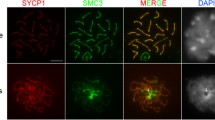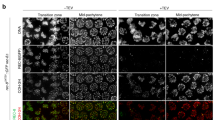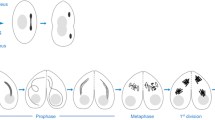Abstract
We have analyzed in a true bug, Graphosoma italicum (Pentatomidae, Hemiptera), the temporal and functional relationships between recombination events, synapsis progression, and SMC1α and SMC3 cohesin axis maturation throughout the male first meiotic prophase. The localization of the histone variant histone H3 trimethylated at lysine 9 at chromosome ends has allowed us to determine the association of these heterochromatic domains through prophase I stages. Results highlighted that cohesins provide to be good markers for synapsis progression since the formation, morphology, and development of the SMC1α and SMC3 cohesin axes resemble the synaptonemal complex dynamics and, also, that in this species the initiation of recombination precedes synapsis. In addition, we have carried out an accurate cytological characterization of the diffuse stage, which takes place after pachytene, and also analyzed the presence of the cohesin subunits, SMC1α and SMC3, and the recombinase RAD51 at this stage. The mechanisms underlying the absence of SMC1α and SMC3 axes from the diffuse stage onwards are discussed.








Similar content being viewed by others
References
Calvente A, Viera A, Page J, Parra MT, Gomez R, Suja JA, Rufas JS, Santos JL (2005) DNA double-strand breaks and homology search: inferences from a species with incomplete pairing and synapsis. J Cell Sci 118:2957–2963
Cardoso H, Stoll M, Dutra A, Oliver G, Di Tomaso MV (1986) Characterization of the diffuse stage in the male meiotic prophase and karyotype of Scapteriscus borellii (Orthoptera: Grylloidea). Genetica 71:23–29
Darlington CD, LaCour LF (1969) The handling of chromosomes. Allen and Unwin, London
de la Fuente R, Parra MT, Viera A, Calvente A, Gomez R, Suja JA, Rufas JS, Page J (2007) Meiotic pairing and segregation of achiasmate sex chromosomes in eutherian mammals: the role of SYCP3 protein. PLoS Genet 3:e198
Dernburg AF, McDonald K, Moulder G, Barstead R, Dresser M, Villeneuve AM (1998) Meiotic recombination in C. elegans initiates by a conserved mechanism and is dispensable for homologous chromosome synapsis. Cell 94:387–398
Eijpe M, Heyting C, Gross B, Jessberger R (2000) Association of mammalian SMC1 and SMC3 proteins with meiotic chromosomes and synaptonemal complexes. J Cell Sci 113(Pt 4):673–682
Esponda P, Stockert JC (1978) Localization of the synaptonemal complex under the light microscope. Chromosoma 68:83–90
Garcia M, Dietrich AJ, Freixa L, Vink AC, Ponsa M, Egozcue J (1987) Development of the first meiotic prophase stages in human fetal oocytes observed by light and electron microscopy. Hum Genet 77:223–232
Garcia-Cao M, O'Sullivan R, Peters AH, Jenuwein T, Blasco MA (2004) Epigenetic regulation of telomere length in mammalian cells by the Suv39h1 and Suv39h2 histone methyltransferases. Nat Genet 36:94–99
Grelon M, Vezon D, Gendrot G, Pelletier G (2001) AtSPO11-1 is necessary for efficient meiotic recombination in plants. Embo J 20:589–600
Henderson KA, Keeney S (2005) Synaptonemal complex formation: where does it start? Bioessays 27:995–998
Hodges CA, Revenkova E, Jessberger R, Hassold TJ, Hunt PA (2005) SMC1beta-deficient female mice provide evidence that cohesins are a missing link in age-related nondisjunction. Nat Genet 37:1351–1355
Jenuwein T, Allis CD (2001) Translating the histone code. Science 293:1074–1080
Kitajima TS, Yokobayashi S, Yamamoto M, Watanabe Y (2003) Distinct cohesin complexes organize meiotic chromosome domains. Science 300:1152–1155
Klásterská I (1976) A new look on the role of the diffuse stage in problems of plant and animal species. Hereditas 82:193–204
Klásterská I (1977) The concept of the prophase on meiosis. Hereditas 86:205–210
Kleckner N (1996) Meiosis: how could it work? Proc Natl Acad Sci U S A 93:8167–8174
Mahadevaiah SK, Turner JM, Baudat F, Rogakou EP, de Boer P, Blanco-Rodriguez J, Jasin M, Keeney S, Bonner WM, Burgoyne PS (2001) Recombinational DNA double-strand breaks in mice precede synapsis. Nat Genet 27:271–276
McKim KS, Hayashi-Hagihara A (1998) mei-W68 in Drosophila melanogaster encodes a Spo11 homolog: evidence that the mechanism for initiating meiotic recombination is conserved. Genes Dev 12:2932–2942
Nicklas RB, Kubai DF, Hays TS (1982) Spindle microtubules and their mechanical associations after micromanipulation in anaphase. J Cell Biol 95:91–104
Page SL, Hawley RS (2004) The genetics and molecular biology of the synaptonemal complex. Annu Rev Cell Dev Biol 20:525–558
Page J, Suja JA, Santos JL, Rufas JS (1998) Squash procedure for protein immunolocalization in meiotic cells. Chromosome Res 6:639–642
Page J, Berrios S, Rufas JS, Parra MT, Suja JA, Heyting C, Fernandez-Donoso R (2003) The pairing of X and Y chromosomes during meiotic prophase in the marsupial species Thylamys elegans is maintained by a dense plate developed from their axial elements. J Cell Sci 116:551–560
Page J, de la Fuente R, Gomez R, Calvente A, Viera A, Parra MT, Santos JL, Berrios S, Fernandez-Donoso R, Suja JA et al (2006) Sex chromosomes, synapsis, and cohesins: a complex affair. Chromosoma 115:250–259
Parra MT, Page J, Yen TJ, He D, Valdeolmillos A, Rufas JS, Suja JA (2002) Expression and behaviour of CENP-E at kinetochores during mouse spermatogenesis. Chromosoma 111:53–61
Parra MT, Viera A, Gomez R, Page J, Benavente R, Santos JL, Rufas JS, Suja JA (2004) Involvement of the cohesin Rad21 and SCP3 in monopolar attachment of sister kinetochores during mouse meiosis I. J Cell Sci 117:1221–1234
Pelttari J, Hoja MR, Yuan L, Liu JG, Brundell E, Moens P, Santucci-Darmanin S, Jessberger R, Barbero JL, Heyting C et al (2001) A meiotic chromosomal core consisting of cohesin complex proteins recruits DNA recombination proteins and promotes synapsis in the absence of an axial element in mammalian meiotic cells. Mol Cell Biol 21:5667–5677
Peters AH, Plug AW, van Vugt MJ, de Boer P (1997) A drying-down technique for the spreading of mammalian meiocytes from the male and female germ line. Chromosome Res 5:66–68
Peters AH, O'Carroll D, Scherthan H, Mechtler K, Sauer S, Schofer C, Weipoltshammer K, Pagani M, Lachner M, Kohlmaier A et al (2001) Loss of the Suv39h histone methyltransferases impairs mammalian heterochromatin and genome stability. Cell 107:323–337
Pigozzi MI, Solari AJ (2003) Differential immunolocalization of a putative Rec8p in meiotic autosomes and sex chromosomes of triatomine bugs. Chromosoma 112:38–47
Prieto I, Tease C, Pezzi N, Buesa JM, Ortega S, Kremer L, Martinez A, Martinez AC, Hulten MA, Barbero JL (2004) Cohesin component dynamics during meiotic prophase I in mammalian oocytes. Chromosome Res 12:197–213
Revenkova E, Jessberger R (2005) Keeping sister chromatids together: cohesins in meiosis. Reproduction 130:783–790
Revenkova E, Eijpe M, Heyting C, Gross B, Jessberger R (2001) Novel meiosis-specific isoform of mammalian SMC1. Mol Cell Biol 21:6984–6998
Roeder GS (1997) Meiotic chromosomes: it takes two to tango. Genes Dev 11:2600–2621
Rufas JS, Gimenez-Martin G (1986) Ultrastructure of the kinetochore in Graphosoma italicum (Hemiptera, Heteroptera). Protoplasma 132:142–148
Stockert JC (1977) Osmium tetroxide/p-phenylenediamine staining of nucleoli and Balbiani rings in Chironomus salivary glands. Histochemistry 53:43–56
Storlazzi A, Tesse S, Ruprich-Robert G, Gargano S, Poggeler S, Kleckner N, Zickler D (2008) Coupling meiotic chromosome axis integrity to recombination. Genes Dev 22:796–809
Strahl BD, Allis CD (2000) The language of covalent histone modifications. Nature 403:41–45
Suja JA, del Cerro AL, Page J, Rufas JS, Santos JL (2000) Meiotic sister chromatid cohesion in holocentric sex chromosomes of three heteropteran species is maintained in absence of axial elements. Chromosoma 109:35–43
Tesse S, Storlazzi A, Kleckner N, Gargano S, Zickler D (2003) Localization and roles of Ski8p protein in Sordaria meiosis and delineation of three mechanistically distinct steps of meiotic homolog juxtaposition. Proc Natl Acad Sci U S A 100:12865–12870
Valdeolmillos AM, Viera A, Page J, Prieto I, Santos JL, Parra MT, Heck MM, Martinez AC, Barbero JL, Suja JA et al (2007) Sequential loading of cohesin subunits during the first meiotic prophase of grasshoppers. PLoS Genet 3:e28
Viera A, Parra MT, Page J, Santos JL, Rufas JS, Suja JA (2003) Dynamic relocation of telomere complexes in mouse meiotic chromosomes. Chromosome Res 11:797–807
Viera A, Calvente A, Page J, Parra MT, Gomez R, Suja JA, Rufas JS, Santos JL (2004a) X and B chromosomes display similar meiotic characteristics in male grasshoppers. Cytogenet Genome Res 106:302–308
Viera A, Santos JL, Page J, Parra MT, Calvente A, Cifuentes M, Gomez R, Lira R, Suja JA, Rufas JS (2004b) DNA double-strand breaks, recombination and synapsis: the timing of meiosis differs in grasshoppers and flies. EMBO Rep 5:385–391
Viera A, Page J, Rufas JS (2009a) Inverted meiosis: the true bugs as a model to study. Genome Dyn 5:137–156
Viera A, Santos JL, Rufas JS (2009b) Relationship between incomplete synapsis and chiasma localization. Chromosoma 118:377–389
Wilson EB (1928) The cell in development and heredity. Macmillan, New York
Zickler D, Kleckner N (1999) Meiotic chromosomes: integrating structure and function. Annu Rev Genet 33:603–754
Acknowledgements
We would like to express our gratitude to Consejería de Medio Ambiente y Ordenación del Territorio (Comunidad de Madrid; España) for emitting the authorization for animal recollections in natural populations, to Dr. José Luis Barbero for generously supplying us the anti-SMC3 anti-SMC1α antibodies, to Dr. Kim McKim for his generous gift of the anti-H2Av antibody, and to Dr. García de la Verga for the critical reading of the manuscript. This work was supported by grants BFU2006-06655, BFU2005-02431, BFU200800459, and BFU2008-00300-BCM from the Ministerio de Educación y Ciencia Spain.
Author information
Authors and Affiliations
Corresponding author
Additional information
Communicated by T. Orr-Weaver
Note added in proofs
A special issue dedicated exclusively to SMC proteins has recently been published in the journal Chromosome Research (vol. 17, 2009). No references about these reviews are included in the text.
Electronic supplementary material
Below is the link to the electronic supplementary material.
SMC3 distribution in squashed spermatocytes. 3-D reconstruction of a field of spermatocytes immunolabeled for SMC3 (green) and DAPI-stained (pseudocolored in red). Leptotene (Le), zygotene (Zy), early-, mid-, and late-pachytene (Pearly, Pmid, and Plate), diffuse, and metaphase I (MI) spermatocytes are observed and one spermatid (Sp). Note the presence of a brighter structure in pachytene and diffuse spermatocytes, corresponding to the chromatin of the sex chromosomes (XY). This video corresponds to the reconstructions of the spermatocytes shown in Fig. 1. See text for further details (MOV 710 kb)
Video 2
RAD51 distribution in a pachytene spermatocyte. 3-D reconstruction of a squashed pachytene spermatocyte immunolabeled for RAD51 (red) and DAPI-stained (blue). Despite RAD51 being located on the autosomal chromatin, it is noteworthy that sex chromosomes (XY) do not show RAD51 signals (MOV 3250 kb)
Rights and permissions
About this article
Cite this article
Viera, A., Santos, J.L., Parra, M.T. et al. Cohesin axis maturation and presence of RAD51 during first meiotic prophase in a true bug. Chromosoma 118, 575–589 (2009). https://doi.org/10.1007/s00412-009-0218-4
Received:
Revised:
Accepted:
Published:
Issue Date:
DOI: https://doi.org/10.1007/s00412-009-0218-4




